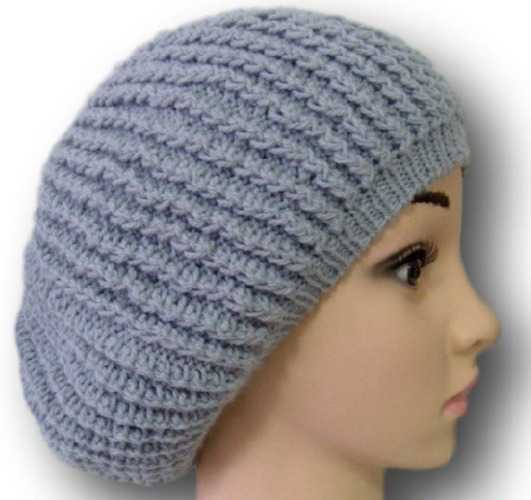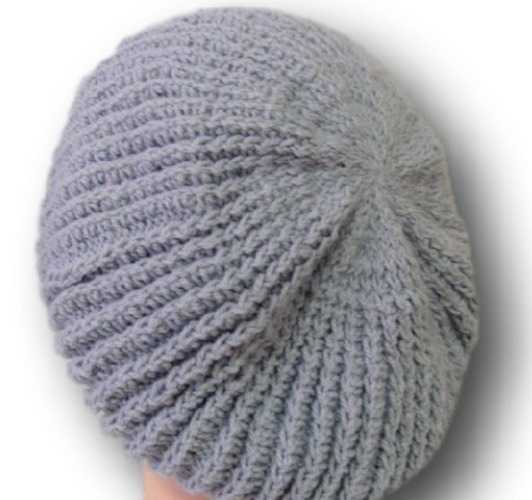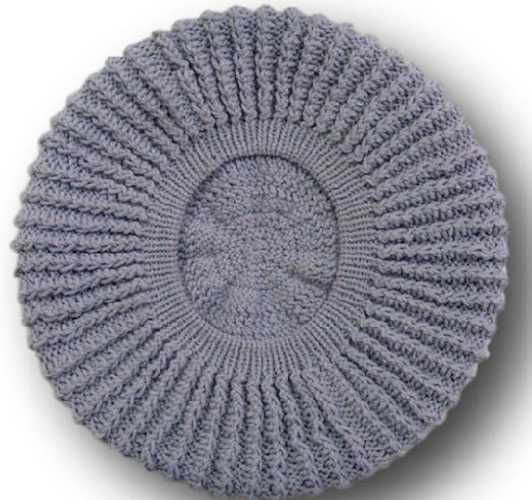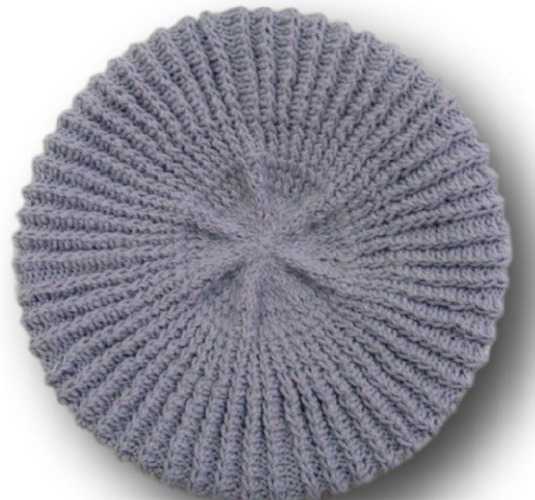French elastic or snake elastic used in knitting hats, allowing the product to be elastic, beautifully fitted and very light.
Knitted with such a pattern using ready-made patterns, the headdress looks very impressive due to the constant crossing of loops. The hat should sit loosely on the head, stretch well, but not lose shape when worn for a long time.
Peculiarities of pattern execution
A hat knitted with a French rib stitch is made according to a pattern with constant alternation of 2 front and 2 back loops with knitting needles, crossing in each rapport.
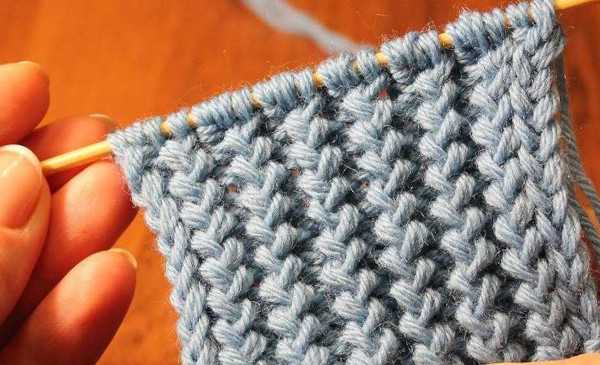
The peculiarity of this pattern is also:
- knitting purl stitches in reverse order;
- alternating knitting in 2 rows;
- presence of one-sided design;
- lack of gradual decrease of loops (when knitting a hat, the product is completed by sharply reducing the number of loops, closing them, and then they are sewn together and the crown is pulled together).
When creating a pattern, the total number of loops cast on to the knitting needles must be a multiple of 4 + 2 or 3 edge loops.
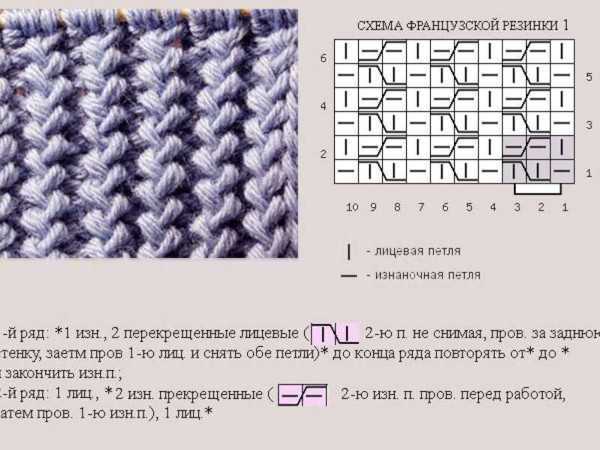
It is also necessary to take into account that:
- Odd rows are considered “front” and consist of 1 edge + 1 purl loop + a repeating pattern of 2 crossed front loops and 2 purl loops throughout the row.
- Even rows are “purl”, knitted according to the pattern – 1 edge + 1 front loop + a rapport of 2 crossed purl and 2 front loops repeated throughout the row.
- To create crossed knit stitches, you need to knit the second stitch, leave it in place, and then knit the first stitch. You can also simply swap them and knit them in sequence.
- When working with crossed purl stitches, the second purl stitch is also knitted first, then the first purl stitch. In this case, you can simply swap them first, and then knit them crossed.
Knitting pattern for the French rib pattern:

| — | designation of purl stitches |
| │ | Designation of face loops |
The 2nd version of the pattern with circular knitting needles also involves working with a number of loops that is a multiple of 4, while:
- Rows 1-2 should be knitted only with front loops;
- on the 3rd row you need to complete a rapport with alternating 2 front + 2 back loops;
- on the 4th row – the pattern changes and consists of one front + 2 back and one front loop;
- Throughout the knitting process, you need to alternate the pattern of “even” and “odd” rows, bringing the fabric to the desired length of the product.
The final stage will be finishing the work on the product, for which the last free loop can be taken to the opposite knitting needle and tied.
Necessary tools
The French rib pattern requires the use of thick or medium thickness wool yarn and knitting needles of the appropriate thickness when knitting.

Tools required for work:
| Yarn | When knitting, you can use threads made from sheep, goat, and rabbit wool, but merino yarn is the most preferable. Suitable for work:
It is not recommended to use angora wool yarn when knitting with French rib. |
| Spokes | When knitting the French rib pattern, it is recommended to use circular knitting needles, and their diameter should be equal to or 1-1.5 times larger than the diameter of the thread.
For beginners, it is recommended to take needles made of wood or bamboo. Experienced craftsmen can use steel ones. |
| Additional tools |
|
Taking measurements and determining the number of loops
Before starting work on the product, it is also necessary to take measurements, using a measuring tape to determine the circumference of the head and the depth of the headdress.
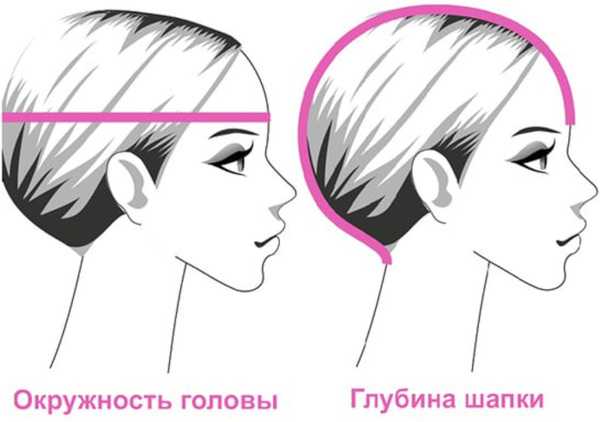
- To clarify the first measurement, apply a centimeter to the protruding point on the forehead and move it around the head, moving towards the back of the head above the eyebrows.
- To determine the depth of the product, a measuring tape should be drawn from the middle of the crown to the earlobe. If the planned headdress should be longer, then the necessary “plus” is included in its length.
After taking measurements, you should determine the number of loops needed to create the hat and the knitting density. To do this, knit a test sample and use a ruler to determine the number of loops included in 1 cm. For example, with a head circumference of 56 cm and 2 loops that fit into 1 cm, you should have 56 * 2 = 112 cast-on loops + 2 edge loops.
In this case, when knitting a hat with a French elastic, the number of loops should be rounded up, if necessary, to a multiple of 4.
To specify the number of knitted rows, the depth value of the product must be increased by the number of loops in 1 cm of the sample, for example, with 22 * 2 = 44 rows. For a hanging beanie-type hat, the number of rows must be additionally increased to 48-50.
Master classes
The French Rib pattern is used to knit a variety of headwear that stretches well and has a loose fit.
With a lapel
A French rib knit hat, the pattern for which is presented below, with a turn-up is made from threads containing sheep or camel wool.

So, for work you will need to take:
- 2-3 skeins of Pekhorka “Sheep’s wool” yarn;
- circular knitting needles No. 5.5.
When working on creating a hat you will need:
- Cast on 113-114 stitches (the exact number is determined depending on the head size) and knit 5-10 cm of fabric (for one or two lapels) with a 2*2 elastic band (alternating 2 front and 2 back loops). Then start knitting the main part of the headdress with a French elastic band. You can also immediately start knitting with the "French elastic" pattern, but for this, the final length of the product will need to be increased by 5-10 cm, which are necessary to create the lapels. When working, you need to complete the 1st row by knitting a pattern of alternating 2 front and 2 back loops after the removed edge loop. The last loop in the row should be a back loop.
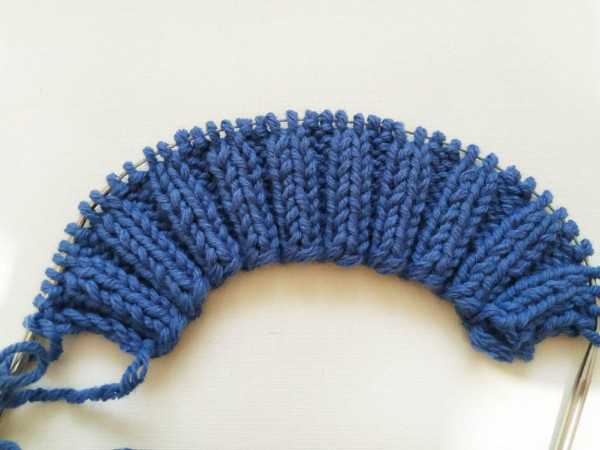
- To create the 2nd row, immediately after the edge row, make a rapport of alternating 2 purl and 2 front loops. In this case, the row should end with a purl loop.

- When working on the 3rd row, completely repeat the pattern of the 1st, and on the 4th, complete the rapport of the 2nd row.
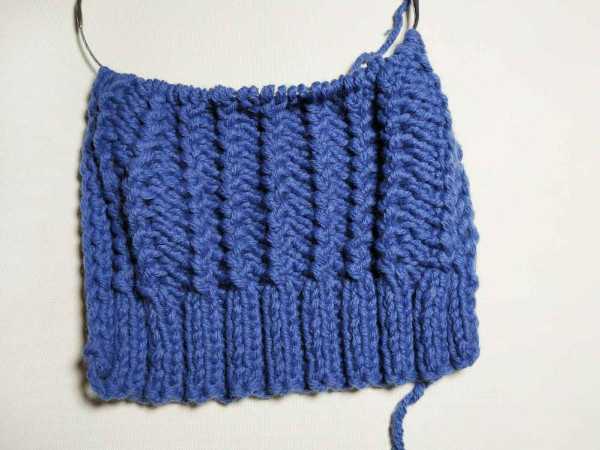
- Proceeding in a similar manner and alternating “even” and “odd” rows, knit 30-35 cm, and on the last 3 rows, begin to form the crown, reducing the number of loops - knitting 2 front (before the edge) loops together at the beginning and end of each row.
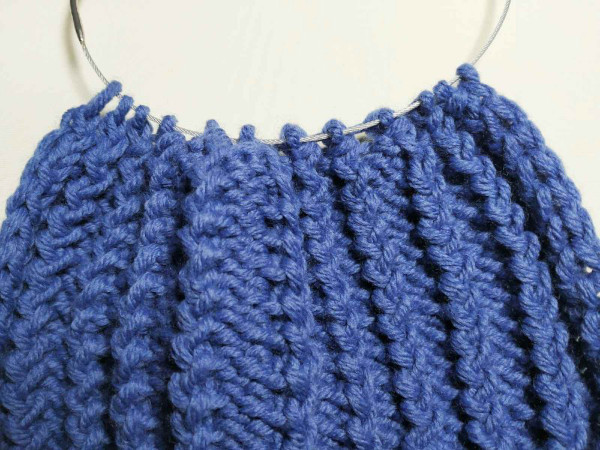
- To close the crown, all remaining loops must be closed, sew the hat with a connecting seam and pull together. Tuck the tail of the thread into the rows using a needle.
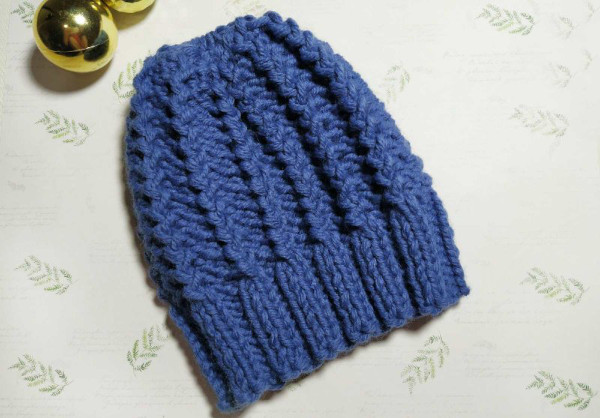
- The resulting hat needs to be tried on and a lapel made and, if desired, decorated with a knitted or fur pompom.
Beanie hat
A French elastic hat with knitting needles, the pattern of which will help beginners, related to the "beanie" model, turns out a little loose, can hang slightly at the back or be decorated with a fur pompom. It is recommended to take yarn for work of medium thickness, for example, "Pekhorka" or Aphrodite Astra Premium in the amount of 150-200 g.
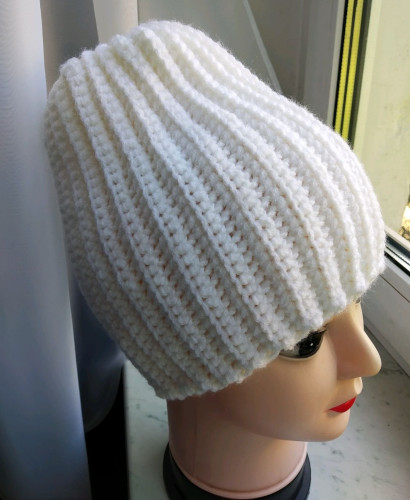
You will also need:
- knitting needles No. 4, 5;
- sewing needle;
- scissors;
- elastic thread;
- cardboard or a special device for making pompoms.
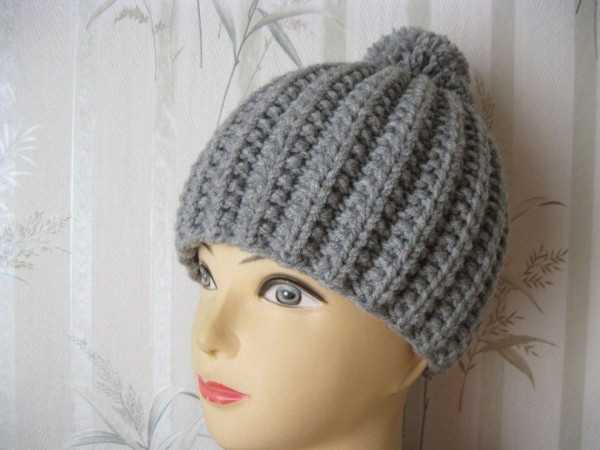
When working on a product, you need to:
- Cast on 119 stitches (with a head circumference of 60 cm) and knit 62 rows (30-35 cm) using the French rib pattern. To do this:
- In the 1st row, make one edge stitch, one purl stitch and a repeating pattern of 2 crossed front stitches and 2 purl stitches throughout the row.
- In the second row, knit one edge and one front loop, and then complete the remaining row with a repeating pattern of 2 crossed purl loops and 2 front loops. The last loop in the row is also made purl.
- In the 3rd and subsequent “odd” rows, you need to repeat the rapport of the 1st row.
- In the 4th and subsequent “even” rows – the pattern of the 2nd row.
- In the last 3 rows, reduce the number of loops by skipping one purl and knitting 2 front loops together, which will tighten the fabric a little.
- Close the last row, sew the hat with a connecting seam and tighten the crown.
- To form a pompom, wind 4-6 layers of thread onto a rectangular piece of cardboard, pull them tightly together on both sides, remove from the cardboard, pull in the middle, and cut along the edges.
- Carefully trim the finished pompom with scissors, removing any protruding threads, and sew it to the top of the beanie hat.
- Instead of a wool pompom, you can also use a ready-made fur pompom.
"Cat"
In a similar way, but without tightening the crown, you can knit a popular hat with ears "Cat", in this case you can take:
- 150g acrylic yarn (eg Red Heart Eco Ways with 70% acrylic and 30% polyester);
- circular knitting needles No. 4.5 and 5.
Knitting density 24 loops = 10 cm
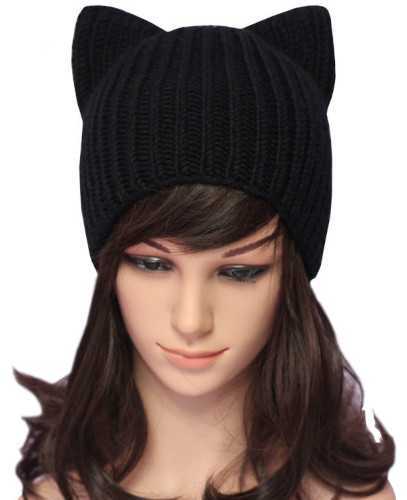
During work you need to:
- Cast on 106/112 stitches on knitting needles No. 4.5 and knit with a 2*2 elastic pattern (alternating 2 front and 2 back stitches) to make a 12 cm piece.
- Change the needles to No. 5 and proceed to work on the main pattern, for which the following rapport is performed:
- In the 1st row - from 2 moved front loops + 2 purl loops. It is repeated throughout the row, and ends with 2 purl loops.
- In the 2nd row - from 2 front + 2 moved purl loops. It is also repeated throughout the row and ends with one purl loop.
- Repeat the pattern of the first row in the 3rd row and the pattern of the 2nd row in the 4th row.
- Proceeding in a similar manner and alternating even and odd rows, you need to knit a product 30-35 cm high and close the loops.
- Fold the hat in half and sew the back seam first, then the top seam in a “T” shape.
Hat-scarf "Pipe"
This French rib hat is best knitted from light wool yarn, which emphasizes the beauty and relief of the pattern, which appears due to the shift in the pattern caused by the alternation of front and back loops in the rows.
The optimal size of such a product is 60 cm in height and 90-110 cm in width, and for work you will need:
- 200-300 g of yarn (for example, Lana Gatto Feeling);
- circular knitting needles No. 4.5-5.
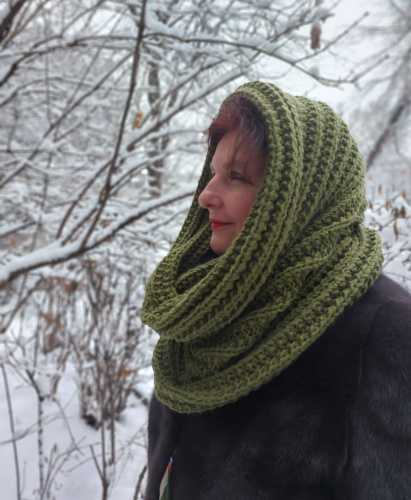
During work you need to:
- Cast on 150 stitches (for symmetry, their number should be a multiple of 4 + 1 stitch) and knit 20 rows with the front surface (in the front rows there will be only front stitches, and in the back rows - only back stitches), thereby completing the top of the hat-scarf.
- Start knitting with the French rib pattern.
To complete step 2:
- In the 1st row there will be a pattern of alternating 2 front and 2 back loops.
- In the 2nd row – the pattern is 2 front + 2 back, but shifted by one loop;
- The 3rd row is knitted exactly like the first.
- 4th row – corresponds to the 2nd row in pattern rapport.
- Proceeding in a similar manner and alternating rows with front and back loops, you need to knit a fabric 60 cm high.
- To complete it, you need to cut the thread, use a needle to pull it through the knitted loops and secure it.
The finished scarf should be tried on by twisting its lower part, knitted with the front surface, around the neck.
Knitted beret
A French elastic hat with knitting needles, the pattern of which requires precise execution of instructions, in the form of a beret will suit girls and women of any age and goes well with any outfit.
You can connect it using:
- 200-300 g of Semenovskaya Sufle yarn;
- circular knitting needles No. 4.5.
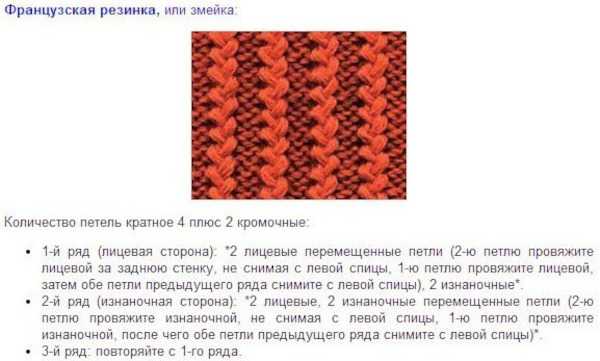
During work you need to:
- Cast on 100-112 stitches (the exact number will depend on the size of your head), distribute them evenly, and then knit 4 rows with a 1*1 elastic band (alternating front and back stitches) to form an elastic edge to the beret.
- Switch to knitting the main fabric of the product using the “French elastic” pattern, for which:
- Perform the 1st (front) row with a repeating rapport of 2 front moved loops (for which, without removing the 2nd loop from the knitting needle, gently knit through the back wall, and then do the same with the first loop) and 2 purl loops.
- Create the 2nd (purl) row with a repeating pattern, starting with 2 knit stitches, followed by 2 purl moved stitches (for which, first the second purl stitch not removed from the needle is knitted, and then the first one). The pattern continues throughout the row.
- Knit the 3rd row, completely copying the rapport of the 1st, and the 4th - with the pattern of the second.
- Proceeding in a similar manner, alternating “front” and “back” rows, you need to knit a 25-30 cm beret, while the size of the fabric can be varied as desired.
- To close the hat, make a small reduction on the last 3 rows by knitting 2 front loops together, then close the remaining loops in the row, sew them together and carefully pull the thread together.
- The resulting product should be tried on and, if desired, decorated with a brooch on the side.
Turban hat
A hat with French elastic knitting needles, the scheme of which includes tips on choosing yarn, "Turban" consists of 2 parts crossed in the middle of the forehead, and to create it you will need:
- 500 g wool yarn (for example, RAINBOW WOOL made from 100% Peruvian wool);
- knitting needles No. 4.5-5.
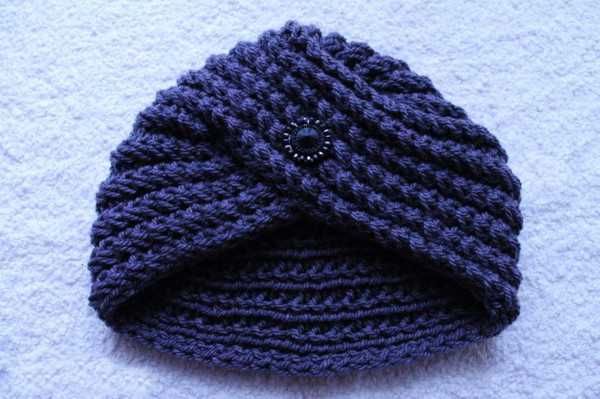
To create the product you will need:
- Cast on 32 stitches (including edge stitches) and begin knitting the pattern, for which you should do the following:
- 1st row of 1 edge stitch + rapport of 1 purl stitch + 2 crossed front stitches (to do this, knit the 2nd stitch without removing it from the back wall, then knit the first stitch and remove both stitches) + 1 purl stitch. The pattern is repeated until the end of the row, which must be finished with a purl stitch.
- 2nd row of 1 edge stitch + rapport of 1 front stitch + 2 crossed purl stitches (in this case, the second stitch is knitted first, then the first stitch) + 1 front stitch. The pattern is repeated to the end of the row, but it must be finished with a purl stitch.
- The 3rd row completely repeats the pattern of the 1st, and the 4th row repeats the pattern of the 2nd row.
- Proceeding in a similar manner and alternating the rapports of the “even” and “odd” rows, you need to make a piece of fabric 120 cm long and close the working loops.
- To form a turban, the resulting scarf must be folded in half and its center must be fixed, then the free ends must be placed on it overlapping each other and tied in a knot. Its free ends must be hidden, pulled to the back of the head and sewn in the center. The turban must also be sewn on the sides.
- To secure the central knot, it is also recommended to secure it with a thread.
Tips for Beginners
Professionals advise girls and women taking their first steps in needlework when knitting:
- Be careful when choosing yarn, purchasing only high-quality threads from trusted manufacturers. For knitting with French elastic, a single-color yarn without lurex and glitter is suitable, allowing you to emphasize the relief of the French elastic and, if necessary, hide defects in the work of a novice master.
- Work only with comfortable knitting needles (for example, wooden or bamboo), corresponding in thickness to the doubled thread. It is not recommended for beginners to knit with steel knitting needles, since in this case it will be difficult for them to cope with loops that easily slip down.
- Control the yarn tension and stitch size, and correct defects promptly if necessary.
- Do not put the work aside until the row you started has been completely knitted, and also use a tailor's marker for markings.
- When buying new circular knitting needles, for convenience, lower them for 2-3 minutes, then pull them out and cool, which will make the line more flexible and prevent it from twisting.
- Use needles that contrast with the shade of the yarn (for example, dark with light threads or vice versa), which will allow you to better see the stitches and control their tension and size.
- It is essential to use a notebook in which all increases/decreases, calculations made to determine the required number of loops, and also the numbers of the knitting needles and article numbers of the threads used are noted.
A hat knitted with a French rib stitch is a stylish accessory made by alternating and mixing purl and knit stitches.
Knitted with knitting needles in various variations according to a pre-selected pattern, it is suitable for any outfit, stretches well and is quite easy to perform, while not requiring strict control over the number of loops due to the lack of their decrease.
Video about hat with French elastic knitting needles
A simple master class on creating a hat with a French elastic band:

